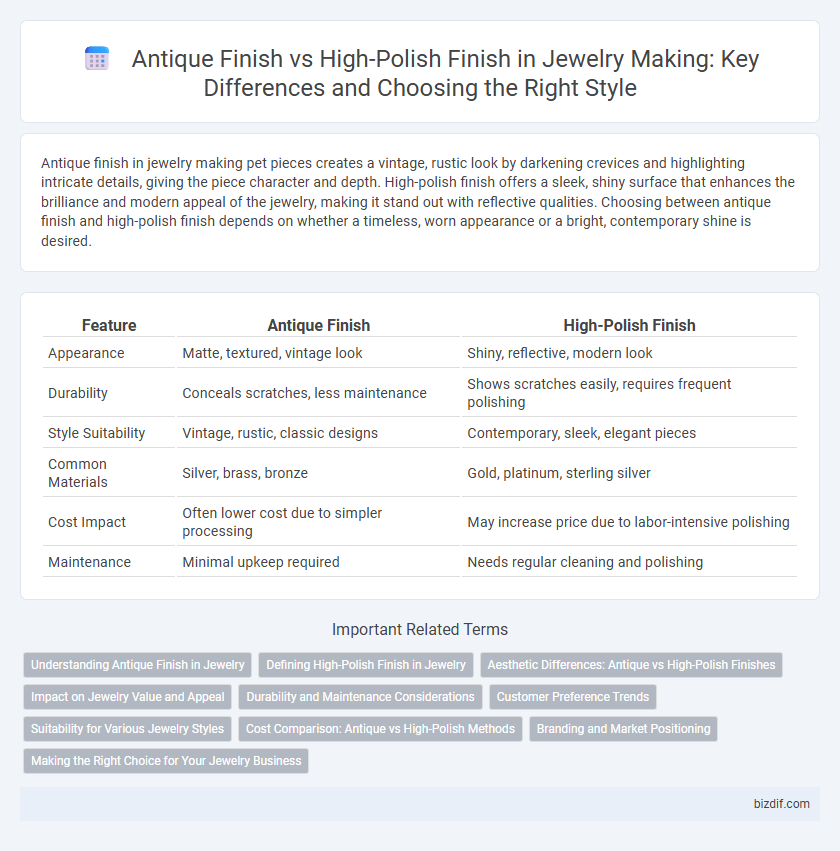Antique finish in jewelry making pet pieces creates a vintage, rustic look by darkening crevices and highlighting intricate details, giving the piece character and depth. High-polish finish offers a sleek, shiny surface that enhances the brilliance and modern appeal of the jewelry, making it stand out with reflective qualities. Choosing between antique finish and high-polish finish depends on whether a timeless, worn appearance or a bright, contemporary shine is desired.
Table of Comparison
| Feature | Antique Finish | High-Polish Finish |
|---|---|---|
| Appearance | Matte, textured, vintage look | Shiny, reflective, modern look |
| Durability | Conceals scratches, less maintenance | Shows scratches easily, requires frequent polishing |
| Style Suitability | Vintage, rustic, classic designs | Contemporary, sleek, elegant pieces |
| Common Materials | Silver, brass, bronze | Gold, platinum, sterling silver |
| Cost Impact | Often lower cost due to simpler processing | May increase price due to labor-intensive polishing |
| Maintenance | Minimal upkeep required | Needs regular cleaning and polishing |
Understanding Antique Finish in Jewelry
Antique finish in jewelry creates a vintage, aged look by adding patina or oxidization, enhancing intricate details and textures often found in classic designs. This finish contrasts with high-polish finish, which delivers a bright, reflective surface that emphasizes smoothness and modern appeal. Understanding antique finish helps jewelers and buyers appreciate the depth and character embedded in every piece, making it ideal for those seeking timeless elegance.
Defining High-Polish Finish in Jewelry
High-polish finish in jewelry is characterized by a mirror-like, reflective surface achieved through extensive buffing and polishing techniques that enhance the metal's brightness and smoothness. This finish accentuates intricate design details by creating a sleek, shiny appearance commonly favored for contemporary and elegant pieces. Compared to the muted, textured look of an antique finish, high-polish emphasizes brilliance and clarity, making metals like gold, silver, and platinum visually striking.
Aesthetic Differences: Antique vs High-Polish Finishes
Antique finishes showcase a vintage, textured look with darker tones and intentional patinas that highlight intricate details and create a timeless, aged appearance. High-polish finishes offer a smooth, reflective surface with bright, mirror-like shine that emphasizes sleekness and modern elegance. The aesthetic contrast lies in antique finishes evoking heritage and depth, while high-polish finishes convey crispness and contemporary luxury.
Impact on Jewelry Value and Appeal
Antique finish enhances jewelry value by adding a vintage, timeless appeal that attracts collectors and enthusiasts seeking unique, character-rich pieces. High-polish finish increases the jewelry's visual impact with its brilliant shine and smooth surface, appealing to those who prefer classic, modern elegance. Both finishes influence market demand differently, with antique finishes often perceived as rare and high-polish finishes valued for their versatility and brightness.
Durability and Maintenance Considerations
Antique finish jewelry features a textured surface that better conceals scratches and tarnish, offering enhanced durability for everyday wear compared to high-polish finishes. High-polish finishes provide a reflective, mirror-like shine but require frequent cleaning and careful handling to prevent visible scratches and dulling over time. Maintenance for antique finishes generally involves gentle cleaning with mild soap, while high-polish finishes benefit from regular polishing to maintain their brilliance.
Customer Preference Trends
Customer preference trends reveal a growing appreciation for antique finishes in jewelry making, as these finishes provide a vintage, rustic appeal that conveys history and uniqueness. High-polish finishes continue to attract buyers seeking sleek, modern aesthetics with a reflective shine that enhances the brilliance of precious metals and gemstones. Market research indicates a balanced demand, with antique finishes preferred for statement pieces and high-polish favored for everyday wear.
Suitability for Various Jewelry Styles
Antique finish offers a vintage, textured look that enhances intricate designs and traditional styles, making it ideal for heirloom and statement pieces. High-polish finish provides a smooth, reflective surface suited for modern, minimalist jewelry that emphasizes clean lines and brightness. Choosing between these finishes depends on the desired aesthetic and the specific jewelry style, with antique appealing to classic elegance and high-polish fitting contemporary trends.
Cost Comparison: Antique vs High-Polish Methods
Antique finishes in jewelry making generally incur higher costs due to the labor-intensive process of hand-texturing and oxidizing metals to achieve a vintage look. High-polish finishes are more cost-effective as they require less time and skill, relying on machine buffing to create a smooth, reflective surface. The choice between antique and high-polish finishes significantly impacts production expenses, with antique methods demanding greater craftsmanship and time investment.
Branding and Market Positioning
Antique finish jewelry embodies a vintage aesthetic that appeals to brands targeting niche markets seeking heritage and craftsmanship, reinforcing authenticity and timelessness in their positioning. High-polish finish pieces attract a broader audience with their sleek, reflective surface, positioning brands as modern, luxurious, and trend-forward. Strategic use of either finish shapes brand identity by aligning product design with consumer expectations and market demand in the jewelry industry.
Making the Right Choice for Your Jewelry Business
Antique finish jewelry showcases a vintage, weathered look with darkened recesses that highlight intricate details, ideal for appealing to customers seeking unique, timeless pieces. High-polish finish offers a sleek, mirror-like shine that emphasizes modern elegance and enhances the brilliance of gemstones, attracting a contemporary clientele. Understanding your target market's preferences and brand identity helps determine whether the rich character of antique finish or the sophisticated allure of high-polish finish will drive your jewelry business success.
Antique finish vs High-polish finish Infographic

 bizdif.com
bizdif.com